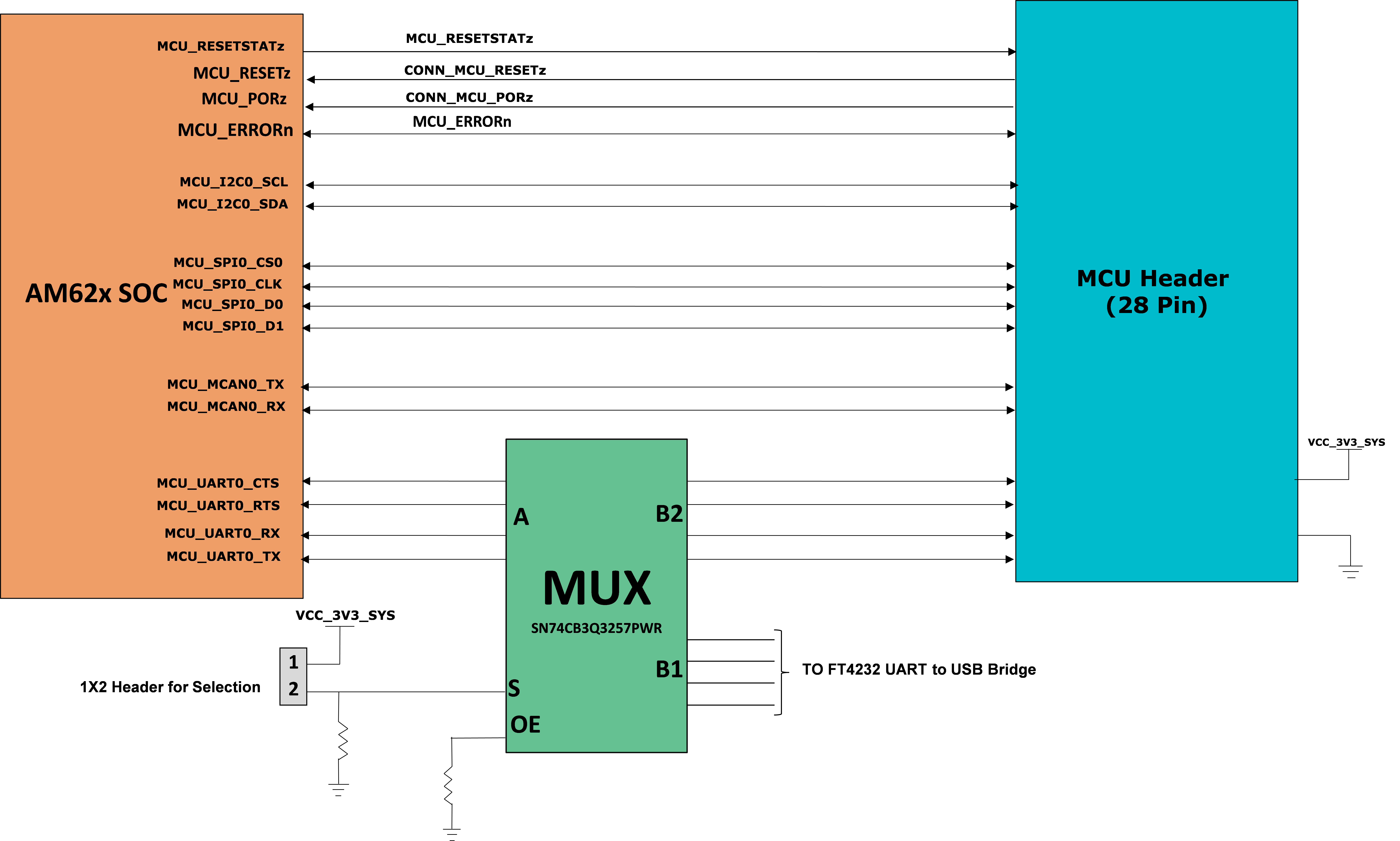SPRUJ40C may 2022 – may 2023
- 1
- Abstract
- Trademarks
- 1EVM Revisions and Assembly Variants
-
2System Description
- 2.1 Key Features
- 2.2 Functional Block Diagram (SK-AM62 and SK-AM62B)
- 2.3 Functional Block Diagram (SK-AM62-P1 and SK-AM62B-P1)
- 2.4 AM62x SKEVM Interface Mapping
- 2.5 Power ON/OFF Procedures
- 2.6
Peripheral and Major Component
Description
- 2.6.1 Clocking
- 2.6.2 Reset
- 2.6.3 OLDI Display Interface
- 2.6.4 CSI Interface
- 2.6.5 Audio Codec Interface
- 2.6.6 HDMI Display Interface
- 2.6.7 JTAG Interface
- 2.6.8 Test Automation Header
- 2.6.9 UART Interface
- 2.6.10 USB Interface
- 2.6.11 Memory Interfaces
- 2.6.12 Ethernet Interface
- 2.6.13 GPIO Port Expander
- 2.6.14 GPIO Mapping
- 2.6.15 Power
- 2.6.16 AM62x SKEVM User Setup/Configuration
- 2.6.17 Expansion Headers
- 2.6.18 Interrupt
- 2.6.19 I2C Address Mapping
-
3Known Issues and Modifications
- 3.1 Issue 1 - HDMI/DSS Incorrect Colors on E1
- 3.2 Issue 2 - J9 and J10 Header Alignment on E1
- 3.3 Issue 3 - USB Boot descoped on E1
- 3.4 Issue 4 - OLDI Connector Orientation and Pinout
- 3.5 Issue 5 - Bluetooth descoped on E2 EVMs
- 3.6 Issue 6 - Ethernet PHY CLK Skew Default Strapping Changes
- 3.7 Issue 7 - TEST_POWERDOWN changes
- 3.8 Issue 8 - MMC1_SDCD spurious interrupts
- 3.9 Issue 9 - PD Controller I2C2 IRQ Not Pinned Out
- 3.10 Issue 10 - INA Current Monitor Adress Changes
- 3.11 Issue 11 - Test Automation I2C Buffer Changes
- Regulatory Compliance
- Revision History
2.6.17.3 MCU Connector
AM62x SKEVM has a 14x2 standard 0.1” spaced MCU connector which includes signals connected to the MCU Domain of SoC. 13 Signals include MCU_I2C0, MCU_UART0 (with flow control), MCU_SPI0 and MCU_MCAN0 signals are connected to the MCU Header. Additional control signals provided on the Header include CONN_MCU_RESETz, CONN_MCU_PORz, MCU_RESETSTATz, MCU_SAFETY_ERRORn, 3.3 V IO and GND. MCU_UART0 signals from AM62x SoC are connected to both MCU Header and FT4232 Bridge through MUX Mfr Part # SN74CB3Q3257PWR. The MCU Header does not include the Board ID memory interface. Allowed current limit is 100 mA on 3.3 V rail.

| Pin No. | SoC Ball No. | Net Name | Pin Multiplexed Signal |
|---|---|---|---|
| 1 | - | VCC_3V3_SYS | |
| 2 | - | DGND | |
| 3 | - | NC | |
| 4 | C9 | MCU_SPI0_D1 | MCU_SPI0_D1/MCU_GPIO0_4 |
| 5 | - | NC | |
| 6 | D9 | MCU_SPI0_D0 | MCU_SPI0_D0/MCU_GPIO0_3 |
| 7 | - | DGND | |
| 8 | B8 | MCU_SPI0_CS1 | MCU_SPI0_CS1/MCU_OBSCLK0/MCU_SYSCLKOUT0/MCU_EXT_REFCLK0/MCU_TIMER_IO1/MCU_GPIO0_1 |
| 9 | - | NC | |
| 10 | E5 | MCU_GPIO0_15 | MCU_MCAN1_TX/MCU_TIMER_IO2/MCU_SPI1_CS1/MCU_EXT_REFCLK0/MCU_GPIO0_15 |
| 11 | D4 | MCU_GPIO0_16 | MCU_MCAN1_RX/MCU_TIMER_IO3/MCU_SPI0_CS2/MCU_SPI1_CS2/MCU_SPI1_CLK/MCU_GPIO0_16 |
| 12 | A6 | MCU_UART0_CTS_CONN | MCU_UART0_CTSn/MCU_TIMER_IO0/MCU_SPI1_D0/MCU_GPIO0_7 |
| 13 | B5 | MCU_UART0_RXD_CONN | MCU_UART0_RXD/MCU_GPIO0_5 |
| 14 | - | NC | |
| 15 | - | DGND | |
| 16 | D6 | MCU_MCAN0_TX | MCU_MCAN0_TX/WKUP_TIMER_IO0/MCU_SPI0_CS3/MCU_GPIO0_13 |
| 17 | B6 | MCU_UART0_RTS_CONN | MCU_UART0_RTSn/MCU_TIMER_IO1/MCU_SPI1_D1/MCU_GPIO0_8 |
| 18 | A7 | MCU_SPI0_CLK | MCU_SPI0_CLK/MCU_GPIO0_2 |
| 19 | A5 | MCU_UART0_TXD_CONN | MCU_UART0_TXD/MCU_GPIO0_6 |
| 20 | - | DGND | |
| 21 | D10 | MCU_I2C0_SDA | MCU_I2C0_SDA/MCU_GPIO0_18 |
| 22 | B3 | MCU_MCAN0_RX | MCU_MCAN0_RX/MCU_TIMER_IO0/MCU_SPI1_CS3/MCU_GPIO0_14 |
| 23 | B12 | MCU_RESETSTATz | MCU_RESETSTATz/MCU_GPIO0_21 |
| 24 | A8 | MCU_I2C0_SCL | MCU_I2C0_SCL/MCU_GPIO0_17 |
| 25 | E11 | CONN_MCU_RESETz | MCU_RESETz |
| 26 | D1 | MCU_SAFETY_ERRORz_3V3 | MCU_ERRORN |
| 27 | - | DGND | |
| 28 | D2 | CONN_MCU_PORz | MCU_PORz |